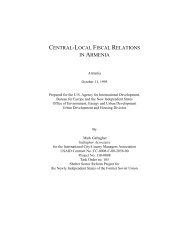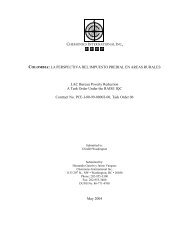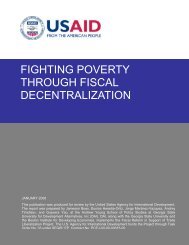Effectiveness and Economic Impact of Tax Incentives in the SADC ...
Effectiveness and Economic Impact of Tax Incentives in the SADC ...
Effectiveness and Economic Impact of Tax Incentives in the SADC ...
You also want an ePaper? Increase the reach of your titles
YUMPU automatically turns print PDFs into web optimized ePapers that Google loves.
6-8 EFFECTIVENESS AND IMPACT OF TAX INCENTIVES IN THE <strong>SADC</strong> REGION<br />
economy from “w<strong>in</strong>n<strong>in</strong>g” <strong>the</strong> project may be small or even negative. The tendency to give<br />
away <strong>the</strong> kitchen s<strong>in</strong>k is especially pronounced if policymakers have an exaggerated idea <strong>of</strong><br />
<strong>the</strong> benefits <strong>and</strong> a limited underst<strong>and</strong><strong>in</strong>g <strong>of</strong> <strong>the</strong> costs <strong>of</strong> tax <strong>in</strong>centives. Moreover, <strong>the</strong>re are<br />
strong political pressures to w<strong>in</strong> projects even when <strong>the</strong> cost is excessively high, particularly if<br />
<strong>the</strong> adverse effects are hidden or deferred.<br />
There is no shortage <strong>of</strong> evidence that <strong>in</strong>ter-jurisdictional competition for <strong>in</strong>vestment <strong>of</strong>ten<br />
leads to outcomes <strong>of</strong> dubious value to <strong>the</strong> “w<strong>in</strong>ner.” For example, UNCTAD (2002, 205) lists<br />
over a dozen <strong>in</strong>ternational showcase projects that leveraged fiscal competition to obta<strong>in</strong><br />
enormous <strong>in</strong>centive packages. The <strong>in</strong>centives alone are estimated to have cost more than<br />
$340,000 per job created <strong>in</strong> a Mercedes plant <strong>in</strong> Brazil, <strong>and</strong> $420,000 per job <strong>in</strong> a Ford plant <strong>in</strong><br />
India. Closer to home, <strong>the</strong> Ramatex textile factory sought concessions from several countries<br />
<strong>in</strong> <strong>the</strong> <strong>SADC</strong> region before accept<strong>in</strong>g a very generous package <strong>of</strong> <strong>in</strong>centives from Namibia. 85<br />
Even with<strong>in</strong> Namibia questions have been raised about <strong>the</strong> value <strong>of</strong> <strong>the</strong> project to <strong>the</strong> country<br />
that won <strong>the</strong> competition (see Exhibit 6-2).<br />
The ma<strong>in</strong> po<strong>in</strong>t <strong>of</strong> this <strong>the</strong>oretical excursion is that cooperation to stem HTC can serve <strong>the</strong><br />
<strong>in</strong>terests <strong>of</strong> <strong>the</strong> countries that are asked to “concede” to reductions <strong>in</strong> fiscal <strong>in</strong>centives as part<br />
<strong>of</strong> a regional tax agreement, as well as <strong>the</strong> countries that feel “prejudiced” by tax breaks given<br />
elsewhere. This observation can be <strong>the</strong> fulcrum for negotiat<strong>in</strong>g a cooperative agreement<br />
with<strong>in</strong> <strong>SADC</strong>.<br />
6.3 Can Jurisdictions Cooperate <strong>in</strong> Mitigat<strong>in</strong>g Harmful <strong>Tax</strong><br />
Competition?<br />
<strong>Tax</strong> competition is here to stay as a feature <strong>of</strong> <strong>the</strong> <strong>in</strong>ternational economy. Sovereign<br />
jurisdictions <strong>in</strong>evitably make different political decisions about <strong>the</strong> level <strong>and</strong> structure <strong>of</strong><br />
taxes. The result<strong>in</strong>g tax differentials <strong>in</strong>herently create competition for <strong>in</strong>ternationally mobile<br />
capital (<strong>and</strong> labor). <strong>Tax</strong> competition can be a healthy <strong>in</strong>ducement for improv<strong>in</strong>g efficiency <strong>in</strong><br />
revenue systems throughout <strong>the</strong> world <strong>and</strong> exp<strong>and</strong><strong>in</strong>g global <strong>in</strong>vestment. But this<br />
competition also generates harmful fiscal externalities from capital migration. Uncoord<strong>in</strong>ated<br />
tax competition (<strong>the</strong> “race to <strong>the</strong> bottom”) also creates strategic choice problems that dim<strong>in</strong>ish<br />
fiscal resources <strong>in</strong> poor countries <strong>and</strong> rich countries alike.<br />
Experience <strong>in</strong> many parts <strong>of</strong> <strong>the</strong> world suggests that it is very difficult to develop effective<br />
cooperative approaches among sovereign jurisdictions to mitigate <strong>the</strong> harmful effects <strong>of</strong> tax<br />
competition. With<strong>in</strong> <strong>the</strong> United States, for example, <strong>the</strong>re has long been concern about <strong>the</strong> cost<br />
85 Not enough data is available to compute <strong>the</strong> cost <strong>of</strong> <strong>in</strong>centives per job created <strong>in</strong> this case, but from <strong>the</strong><br />
<strong>in</strong>formation given <strong>in</strong> Exhibit 6.2, <strong>the</strong> subsidy for site preparation alone amounted to $20,000 per job created as<br />
<strong>of</strong> April 2003.











